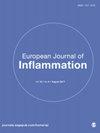氢气治疗通过改善横纹肌溶解提高挤压综合征大鼠模型的存活率
IF 0.8
4区 医学
Q4 IMMUNOLOGY
引用次数: 0
摘要
挤压综合征(CS)的特点是外伤性横纹肌溶解的全身性表现,可导致多器官功能障碍和死亡。缺血再灌注(IR)损伤通常是全身反应的原因。进一步的研究表明,在许多实验模型中,氢气处理可以改善IR损伤;然而,其对CS的影响尚未得到很好的研究。本研究旨在探讨氢气吸入对大鼠挤压伤后的影响。雄性Sprague-Dawley大鼠在全身麻醉下,后肢施加总重量为3.0 kg的实验CS,持续6小时。减压后立即随机放置在充满空气或1.3%氢气的毒气室中。动物在气体暴露后18 h或24 h分别被处死,用于非生存研究或生存研究。氢气处理大鼠(n = 6)的24 h存活率高于空气处理大鼠(n = 9) (100% vs. 44%, p = 0.035)。减压18 h后,氢气组乳酸浓度(2.9±0.2 vs 2.2±0.2 mmol/L, p = 0.040)和肌酸激酶(34,178±13,580 vs 5005±842 IU/L, p = 0.016)低于空气组(空气组n = 4, H2组n = 5)。组织学分析显示,氢治疗对股直肌和肾脏的损伤似乎得到了改善。氢气吸入可能是一种很有前途的治疗方法。本文章由计算机程序翻译,如有差异,请以英文原文为准。
Hydrogen gas treatment improves survival in a rat model of crush syndrome by ameliorating rhabdomyolysis
Crush syndrome (CS) is characterized by a systemic manifestation of traumatic rhabdomyolysis, leading to multiple organ dysfunction and death. Ischemia-reperfusion (IR) injury is commonly responsible for systemic response. Extending studies have shown that hydrogen gas treatment ameliorated IR injury in numerous experimental models; however, its effect on CS has not been well examined. This study aimed to investigate the effects of hydrogen gas inhalation following crush injury in an experimental model of CS. Male Sprague-Dawley rats were subjected to experimental CS by applying a total of 3.0 kg weight to both hindlimb under general anesthesia for 6 h. Immediately after decompression, the animals were randomly placed in a gas chamber filled with either air or 1.3% hydrogen gas. Animals were sacrificed 18 h or 24 h following gas exposure for non-survival studies or for survival study, respectively. The rats with hydrogen treatment ( n = 6) had a higher 24-h survival than the rats with air treatment ( n = 9) (100% vs. 44%, p = 0.035). Lactate concentrations (2.9 ± 0.2 vs. 2.2 ± 0.2 mmol/L, p = 0.040) and creatine kinase (34,178 ± 13,580 vs. 5005 ± 842 IU/L, p = 0.016) were lower in the hydrogen group compared with the air group 18 h after decompression ( n = 4 in the air group, and n = 5 in the H2 group). Histological analysis revealed that the damage to the rectus femoris muscle and kidney appeared to be ameliorated by hydrogen treatment. Hydrogen gas inhalation may be a promising therapeutic approach in the treatment of CS.
求助全文
通过发布文献求助,成功后即可免费获取论文全文。
去求助
来源期刊
CiteScore
0.90
自引率
0.00%
发文量
54
审稿时长
15 weeks
期刊介绍:
European Journal of Inflammation is a multidisciplinary, peer-reviewed, open access journal covering a wide range of topics in inflammation, including immunology, pathology, pharmacology and related general experimental and clinical research.

 求助内容:
求助内容: 应助结果提醒方式:
应助结果提醒方式:


